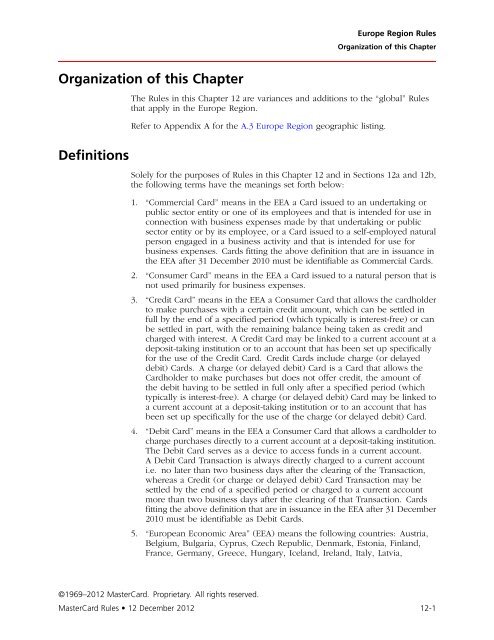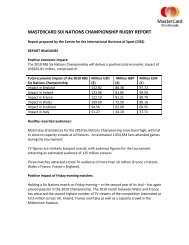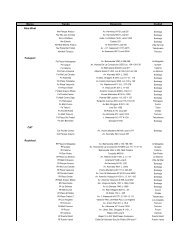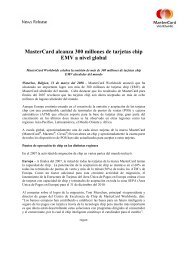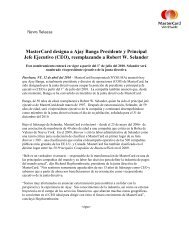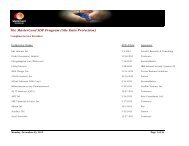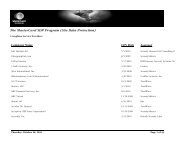MasterCard Rules (PDF)
MasterCard Rules (PDF)
MasterCard Rules (PDF)
You also want an ePaper? Increase the reach of your titles
YUMPU automatically turns print PDFs into web optimized ePapers that Google loves.
Organization of this Chapter<br />
Definitions<br />
Europe Region <strong>Rules</strong><br />
Organization of this Chapter<br />
The <strong>Rules</strong> in this Chapter 12 are variances and additions to the “global” <strong>Rules</strong><br />
that apply in the Europe Region.<br />
Refer to Appendix A for the A.3 Europe Region geographic listing.<br />
Solely for the purposes of <strong>Rules</strong> in this Chapter 12 and in Sections 12a and 12b,<br />
the following terms have the meanings set forth below:<br />
1. “Commercial Card” means in the EEA a Card issued to an undertaking or<br />
public sector entity or one of its employees and that is intended for use in<br />
connection with business expenses made by that undertaking or public<br />
sector entity or by its employee, or a Card issued to a self-employed natural<br />
person engaged in a business activity and that is intended for use for<br />
business expenses. Cards fitting the above definition that are in issuance in<br />
the EEA after 31 December 2010 must be identifiable as Commercial Cards.<br />
2. “Consumer Card” means in the EEA a Card issued to a natural person that is<br />
not used primarily for business expenses.<br />
3. “Credit Card” means in the EEA a Consumer Card that allows the cardholder<br />
to make purchases with a certain credit amount, which can be settled in<br />
full by the end of a specified period (which typically is interest-free) or can<br />
be settled in part, with the remaining balance being taken as credit and<br />
charged with interest. A Credit Card may be linked to a current account at a<br />
deposit-taking institution or to an account that has been set up specifically<br />
for the use of the Credit Card. Credit Cards include charge (or delayed<br />
debit) Cards. A charge (or delayed debit) Card is a Card that allows the<br />
Cardholder to make purchases but does not offer credit, the amount of<br />
the debit having to be settled in full only after a specified period (which<br />
typically is interest-free). A charge (or delayed debit) Card may be linked to<br />
a current account at a deposit-taking institution or to an account that has<br />
been set up specifically for the use of the charge (or delayed debit) Card.<br />
4. “Debit Card” means in the EEA a Consumer Card that allows a cardholder to<br />
charge purchases directly to a current account at a deposit-taking institution.<br />
The Debit Card serves as a device to access funds in a current account.<br />
A Debit Card Transaction is always directly charged to a current account<br />
i.e. no later than two business days after the clearing of the Transaction,<br />
whereas a Credit (or charge or delayed debit) Card Transaction may be<br />
settled by the end of a specified period or charged to a current account<br />
more than two business days after the clearing of that Transaction. Cards<br />
fitting the above definition that are in issuance in the EEA after 31 December<br />
2010 must be identifiable as Debit Cards.<br />
5. “European Economic Area” (EEA) means the following countries: Austria,<br />
Belgium, Bulgaria, Cyprus, Czech Republic, Denmark, Estonia, Finland,<br />
France, Germany, Greece, Hungary, Iceland, Ireland, Italy, Latvia,<br />
©1969–2012 <strong>MasterCard</strong>. Proprietary. All rights reserved.<br />
<strong>MasterCard</strong> <strong>Rules</strong> • 12 December 2012 12-1


